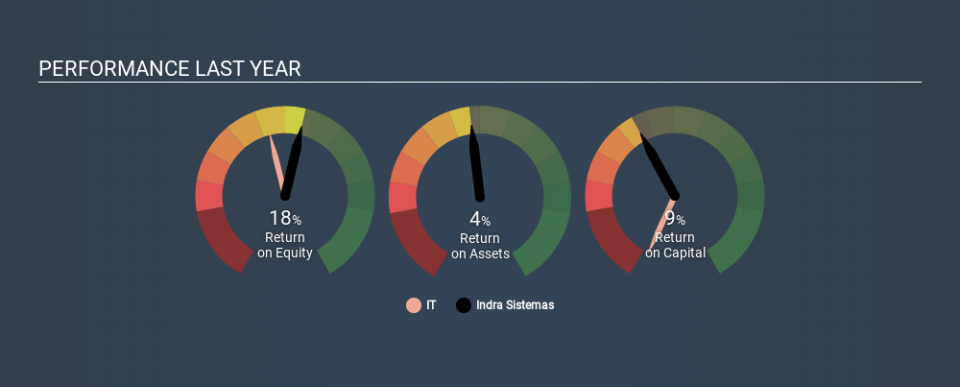Has Indra Sistemas, S.A. (BME:IDR) Been Employing Capital Shrewdly?

Today we'll look at Indra Sistemas, S.A. (BME:IDR) and reflect on its potential as an investment. Specifically, we'll consider its Return On Capital Employed (ROCE), since that will give us an insight into how efficiently the business can generate profits from the capital it requires.
First up, we'll look at what ROCE is and how we calculate it. Then we'll compare its ROCE to similar companies. Finally, we'll look at how its current liabilities affect its ROCE.
Understanding Return On Capital Employed (ROCE)
ROCE is a metric for evaluating how much pre-tax income (in percentage terms) a company earns on the capital invested in its business. Generally speaking a higher ROCE is better. Ultimately, it is a useful but imperfect metric. Author Edwin Whiting says to be careful when comparing the ROCE of different businesses, since 'No two businesses are exactly alike.
So, How Do We Calculate ROCE?
Analysts use this formula to calculate return on capital employed:
Return on Capital Employed = Earnings Before Interest and Tax (EBIT) ÷ (Total Assets - Current Liabilities)
Or for Indra Sistemas:
0.085 = €210m ÷ (€4.2b - €1.7b) (Based on the trailing twelve months to September 2019.)
Therefore, Indra Sistemas has an ROCE of 8.5%.
See our latest analysis for Indra Sistemas
Is Indra Sistemas's ROCE Good?
One way to assess ROCE is to compare similar companies. We can see Indra Sistemas's ROCE is around the 9.3% average reported by the IT industry. Regardless of where Indra Sistemas sits next to its industry, its ROCE in absolute terms appears satisfactory, and this company could be worth a closer look.
Indra Sistemas has an ROCE of 8.5%, but it didn't have an ROCE 3 years ago, since it was unprofitable. That suggests the business has returned to profitability. The image below shows how Indra Sistemas's ROCE compares to its industry, and you can click it to see more detail on its past growth.
It is important to remember that ROCE shows past performance, and is not necessarily predictive. Companies in cyclical industries can be difficult to understand using ROCE, as returns typically look high during boom times, and low during busts. ROCE is only a point-in-time measure. What happens in the future is pretty important for investors, so we have prepared a free report on analyst forecasts for Indra Sistemas.
What Are Current Liabilities, And How Do They Affect Indra Sistemas's ROCE?
Liabilities, such as supplier bills and bank overdrafts, are referred to as current liabilities if they need to be paid within 12 months. The ROCE equation subtracts current liabilities from capital employed, so a company with a lot of current liabilities appears to have less capital employed, and a higher ROCE than otherwise. To check the impact of this, we calculate if a company has high current liabilities relative to its total assets.
Indra Sistemas has current liabilities of €1.7b and total assets of €4.2b. Therefore its current liabilities are equivalent to approximately 41% of its total assets. Indra Sistemas has a middling amount of current liabilities, increasing its ROCE somewhat.
Our Take On Indra Sistemas's ROCE
Indra Sistemas's ROCE does look good, but the level of current liabilities also contribute to that. Indra Sistemas looks strong on this analysis, but there are plenty of other companies that could be a good opportunity . Here is a free list of companies growing earnings rapidly.
For those who like to find winning investments this free list of growing companies with recent insider purchasing, could be just the ticket.
If you spot an error that warrants correction, please contact the editor at editorial-team@simplywallst.com. This article by Simply Wall St is general in nature. It does not constitute a recommendation to buy or sell any stock, and does not take account of your objectives, or your financial situation. Simply Wall St has no position in the stocks mentioned.
We aim to bring you long-term focused research analysis driven by fundamental data. Note that our analysis may not factor in the latest price-sensitive company announcements or qualitative material. Thank you for reading.



